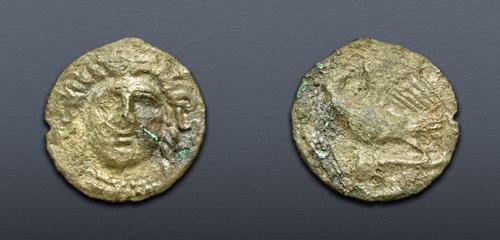
|
SKYTHIA, Olbia. Circa 350-330 BC. Cast Æ (63.5mm, 74.43 g, 12h). Fine.
Electronic Auction 566
Lot: 39. Estimated: $ 300
Greek, 12h, Bronze
Sold For $ 750. This amount does not include the buyer’s fee.
Go to Live
|
|
SKYTHIA, Olbia. Circa 350-330 BC. Cast Æ (63.5mm, 74.43 g, 12h). Wreathed head of Demeter facing / Sea eagle standing left, wings spread and head right, on dolphin left. Anokhin 233; Karyshkovskij p. 399, Таб. VI=B, 1–2; Frolova & Abramzon 231–4; HGC 4, 1882. Rough olive green patina, some spots of encrustation. Fine. Very rare.
From the Skillman Collection.
These are the final cast bronze coins of Olbia during the Classical Period, as well as the final large cast bronze asses in Olbia's history. There are 8 different varieties known, distinguished by the letters and/or symbol on their reverse. Letters A, B, Γ, and E are known without other symbols, while Δ is found with a star, and Y with an ear of grain. An ear of grain also occurs without a letter, and some examples have no letters or symbols at all. The appearance of these letters and symbols may reflect a change in the political structure of the city. In numismatics, the appearance of letters on pre-Hellenistic coinage have often been connected with oligarchy (see, for instance, coins of Samos [Barron, pp. 40-3, 89-93] and Tauric Chersonesos [Anokhin, Khersonesa, pp. 44-45]). Thus, an oligarchic system may have been reinstated at Olbia circa 350 BC. In 334 BC, Alexander the Great changed the ruling oligarchy in Miletos, the parent city of Olbia, and a desire to change the political situation in Olbia may have prompted Alexander's general Zopyrion to besiege the city in circa 330 BC.
Closing Date and Time: 17 July 2024 at 10:12:40 ET.
All winning bids are subject to a 20% buyer’s fee.
|
